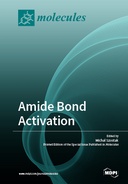Explore

The amide bond represents a privileged motif in chemistry. The recent years have witnessed an explosion of interest in the development of new chemical transformations of amides. These developments cover an impressive range of catalytic N–C bond activation in electrophilic, Lewis acid, radical, and nucleophilic reaction pathways, among other transformations. Equally relevant are structural and theoretical studies that provide the basis for chemoselective manipulation of amidic resonance. This monograph on amide bonds offers a broad survey of recent advances in activation of amides and addresses various approaches in the field.
This book is included in DOAB.
Why read this book? Have your say.
You must be logged in to comment.
Rights Information
Are you the author or publisher of this work? If so, you can claim it as yours by registering as an Unglue.it rights holder.Downloads
This work has been downloaded 208 times via unglue.it ebook links.
- 88 - pdf (CC BY-NC-ND) at Unglue.it.
Keywords
- Activation
- acyl transfer
- acylative cross-coupling
- addition reaction
- additivity principle
- alkynes
- amidation
- amide
- amide activation
- amide bond
- amide bond activation
- amide bond resonance
- amide bonds
- amide C–N bond activation
- amide hydrolysis
- amide resonance
- Amides
- amidicity
- amination
- amine
- amino acid transporters
- aminoacylation
- aminosulfonylation
- anomeric effect
- antibacterial screening
- antiviral activity
- aryl esters
- aryl thioamides
- arynes
- base-catalyed hydrolysis
- biofilm eradication
- bridged lactams
- bridged sultams
- C-H functionalization
- C-H/C-N activation
- C-N ? bond cleavage
- C-S formation
- carbanions
- carbonylation
- carbonylicity
- Catalysis
- catalyst
- catalysts
- Chemistry
- cis/trans isomerization
- cross-coupling
- crown ether
- cyanation
- cyclization
- cyclopentadienyl complexes
- cytostatic activity
- C–H acidity
- C–H bond cleavage
- C–N bond cleavage
- C–O activation
- density functional theory
- density-functional theory
- DFT study
- dipeptides
- directing groups
- distortion
- DMAc
- DMF
- Entropy
- Enzymes
- ester bond activation
- excited state
- formylation
- fumardiamide
- gemcitabine prodrug
- HERON reaction
- heterocycles
- homogeneous catalysis
- hypersensitivity
- In situ
- insertion
- intein
- intramolecular catalysis
- kinetic
- Mathematics & science
- metabolic stability
- metal complexes
- Michael acceptor
- model compound
- Molecular Dynamics
- multi-component coupling reaction
- N
- N,N-dimethylacetamide
- N,N-dimethylformamide
- N-(1-naphthyl)acetamide
- N-dimethylacetamide
- N-dimethylformamide
- N-heterocyclic carbene
- N-heterocyclic carbenes (NHCs)
- nickel catalysis
- nitro-aci tautomerism
- nitrogen heterocycles
- non planar amide
- nuclear magnetic resonance
- N–C activation
- organic synthesis
- Palladium
- palladium catalysis
- pancreatic cancer cells
- Pd-catalysis
- peptide bond cleavage
- pharmacokinetics
- Physical organic Chemistry
- pre-catalysts
- primaquine
- protease
- pyramidal amides
- reaction mechanism
- reaction thermodynamics
- rhodium
- rotational barrier energy
- ruthenium (Ru)
- secondary amides
- sodium
- steric effects
- succindiamide
- sulfonamide bond
- Suzuki-Miyaura
- Synthesis
- tert-butyl
- thioamidation
- thiourea
- transamidation
- transition metals
- transition-metal-free
- trialkylborane
- twisted amide
- twisted amides
- water solvation
- Winkler-Dunitz parameters
- [2+2+2] annulation
Links
DOI: 10.3390/books978-3-03921-204-0Editions


